Wed 23 Feb 2011
by George Kelley
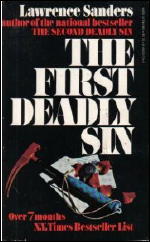
Lawrence Sanders is an inconsistent writer: he can turn out crud like The Pleasures of Helen and Love Songs, then startle readers with powerful novels like The First Deadly Sin (Putnam, 1973; Berkley, 1974), The Second Deadly Sin (Putnam, 1977; Berkley, 1978), and The Sixth Commandment (Putnam, 1979; Berkley 1980).
The First Deadly Sin is a one-on-one contest between a psycho named Daniel Blank and Captain Edward X. Delaney of the New York Police Department. Daniel Blank is obviously named by Sanders to represent a person reaching his limit; here’s how Blank sees the city he lives in:
Blank, divorced and alone, meets the fabulously wealthy Celia Montfort. A strange, sick relationship develops to the point where Blank decides he must prove his love to Celia. He does: Blank randomly picks a victim and kills him.
Blank returns to Celia and describes his feelings: “It really was pure. I swear it. It was religious. I was God’s will. I know that sounds insane. But that’s how I felt. Maybe it is mad. A sweet madness. I was God on earth. When I looked at people on shadowed streets Is he the one? Is he the one? My God, the power!” (Page 168.)
The man Blank murdered was Frank Lombard, a Brooklyn city councilman. The politicians of New York scream for vengeance and the inter-departmental maneuvers begin, first to solve the case quickly and reap the glory, later to scapegoat when the random killings continue.
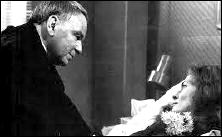
Delaney, asked by a cabal of police officers to quietly investigate the killings while he’s on leave, quickly comes up with important leads. Sanders plays fair with the reader: The First Deadly Sin is a near 600 page book, but the realistic frustration of following leads that turn out to be dead ends, the frustration of developing evidence, produces a long and involved narrative.
The character of Delaney, affectionately called “Iron Balls” by his fellow police officers, is interesting because of his toughness and his passion for order. His method consists of building a mental picture of the murderer, piece by piece:
Blank kills again. And again. Delaney’s mental pictures are still fuzzy. But Blank is slowly losing control: on his job he is aloof and distant. With Celia, with Celia’s brother, Blank’s sex acts become more bizarre. The killings inflame him:
The eerie picture of Daniel Blank is Sanders’ best writing: convincing and frightening at the same time. If The First Deadly Sin has a major weakness it is its ending. The one-on-one confrontation between Delaney and Blank breaks down and we are left with a drawn-out, frustrating ending.
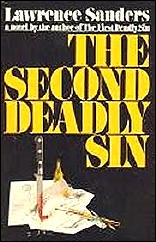
The Second Deadly Sin again features Delaney, but this time he’s drawn out of retirement to track down a murderer of a great painter.
Victor Maitland is stabbed to death and Delaney discovers a dozen suspects who’d like him dead. This is a whodunit, suspenseful and cleverly plotted.
Through the course of the book, it is Delaney, the character of an experienced and ruthless defender of justice, which overshadows the Maitland murder:
And, in the conclusion, Delaney forces the one-on-one confrontation and dishes out his own kind of justice.
The Sixth Commandment is a strange book. The story is told in the first person by Samuel Todd, an investigator for a philanthropic organization. Dr. Thorndecker, a Nobel Prize winner, asks the organization Todd works for for a million dollar grant to support his research.
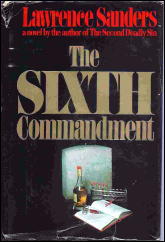
The organization has Todd investigate the Thorndecker proposal. Almost immediately, Todd receives an anonymous note: “Thorndecker kills.” Todd visits the site of the Thorndecker facility near the town of Coburn, north of New York City on the Hudson River. Initially he thinks the note is a con:
But Todd finds this isn’t a simple case of jealousy; there’s murder and madness and horror in Coburn beyond Todd’s wildest nightmares.
I recommend all three of Sanders’ books I’ve reviewed here. Sometimes the writing is wooden and dull, sometimes the characters are dull and superficial. But whatever Sanders’ faults, the books move with a power and intensity you should experience.
Editorial Notes: This article appeared before the film version of The First Deadly Sin was released in 1980. The movie’s two leading co-stars were Frank Sinatra and Faye Dunaway, with David Dukes as Daniel Blank. Other books in the series were The Third Deadly Sin (1981) and The Fourth Deadly Sin (1985).
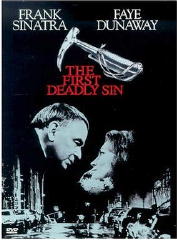
Other books in the “Commandment” series: Seventh (1991), Eighth (1986), and Tenth (1980). Sanders eventually turned his attention to series character Palm Beach PI Archie McNally, beginning with McNally’s Luck in 1992, although some if not all of the writing is said to have been done by ghostwriter Vincent Gardo.
There were seven in this lighthearted series under Sanders’ byline. When the latter died in 1998, Gardo wrote another five under his own name.
George Kelley’s blog can be found online here, where he finds something interesting to review and talk almost every day.
February 23rd, 2011 at 8:24 pm
In his day, Lawrence Sanders must have kept his publisher’s printing presses going overtime. His books were extremely popular. Back when there were used bookstores to go into, their shelves were filled to overflowing with his work.
Today of course, he’s just another all but forgotten author.
James Patterson is the closest I can think of an equivalent now, in terms of quantity if not necessarily quality, right down to the co-writers he uses. Perhaps in 10 or 20 years Patterson’s work will be equally forgotten? It is hard to say.
February 23rd, 2011 at 9:18 pm
Or, like Roderick Thorp and perhaps even Richard Condon, mostly remembered for the films adapted from his work?
I was surprised to see a serious student of crime fiction recently vaguely wonder about a comparable figure to these…
February 23rd, 2011 at 11:15 pm
Your comparison of Patterson and Sanders is quite apt, Steve. Unfortunately, Patterson does not seem to write novels anymore: he just outlines them for his stable of ghost writers. Sanders wrote his own work until the end of his career when he farmed some of it out to Gardo.
February 24th, 2011 at 3:05 am
Sanders and Patterson also have in common that I only managed to read a couple of their books. Some of the early Pattersons were enjoyable, but frankly Sanders escaped me completely. I kept trying over the years, but he was so uneven.
FIRST DEADLY SIN was probably the best of the lot — ANDERSON TAPES was a good idea but I wasn’t impressed with the execution.
Overall they are two highly successful writers whose work I just don’t care much for. I’m sure Patterson worries about that all the way to the bank.
Quite a few of the big names today seem to me too prolific for their own good churning out uneven books that sell in big numbers but seldom really seem worth the effort to read. We all know the names, and we all know the reason too — and I can’t blame them — the contracts and the checks pour in and it must be hard not to sell out and enjoy the rewards.
Hey, someone give me a seven figure offer to sell out — please. Hell, two figures and an Arby’s coupon might do it. That’s the trouble with the world — there’s never any one to tempt you to sell out when you need them. What use is integrity if no one ever tests it for you?
February 24th, 2011 at 9:57 am
I was going to mention that ANDERSON TAPES was Delaney’s first appearance, though I read it after several of the SIN titles. And I only read the first two of the COMMANDMENT books (Sixth and Tenth); I guess I lost track of the series.
I think the comparison with Patterson is a good one, though George’s analysis is on the mark as to Sanders writing his own books, at least for the most part.
He wasn’t as big as Patterson but he was widely read and it’s amazing how quickly he’s been forgotten.
February 25th, 2011 at 12:58 am
I might be wrong but I think ANDERSON TAPES and FIRST DEADLY SIN were the only two movies made of Sanders’ books. I wonder why that might have been. I think both quite quite successful. According to IMBD, Ralph Meeker played Delaney in TAPES. I sure didn’t remember that!
Maybe the combination of Sean Connery and Dyan Cannon sucked everything else out of my memory.
February 25th, 2011 at 1:21 am
I left this comment after one of the Simon Brett books, following one left by David Vineyard in which he brought up Robert B. Parker and the Spenser books. I had this post in mind also, so it’s worth repeating here, adding Sanders to the list of successful mystery writers who (must have) appealed to readers not otherwise mystery fans:
Parker’s hardcore fans stuck with him, no matter what he wrote — and there were more of them than us, speaking of general hardcore mystery fans — a smaller crowd, no matter how you look at it. If you were to illustrate with a Venn diagram, you’d have two circles, one smaller than the other, but with a certain amount of overlap — mystery fans who stayed with Parker all the way, unlike you and I, David, who sort of abandoned him. In my case not because of any particular dislike, but by simply going on to other authors.
To make money at writing crime fiction, like Parker did, I assume, and fellows like Lee Child and James Patterson, you’ve got to appeal outside of the smaller circle. Whether that requires settling for a lower standard, I wouldn’t want to say, but at least it’s a different standard.
February 25th, 2011 at 7:22 am
Steve
I’ll answer here since it is the most recent post.
I don’t disagree with you, and I admit I’ve stuck with some writers I have affection for who aren’t literary wonders (and some unlike Parker never were).
Whatever led me astray from Parker or P.D. James was as much me as them. Probably more me than them.
I try to keep that insider thing in mind in regard to many writers, and also to admit that some fine writers in the genre don’t break out because they don’t pander or write the kind of books that make the best seller lists.
Dean Koontz, who is a writer I don’t much read anymore, never the less wrote a fine book on writing years ago and pointed out that best selling fiction is a genre as much as mystery, sf, or westerns. He called them BSN’s — Big Sexy Novels — and writing one successfully is no small achievement whatever the relative literary skill involved.
I should say I have no problem with the success of any writer. Good or bad it is an achievement to just get in print. There are some I feel less than generous towards, but even in those cases I often recognise what about their work attracts readers and makes sales.
Being a mere human I might at times wish the main reading public was a bit more discerning or had a bit less herd instinct, and yet some damn fine writers have also made the big time — Steig Larrson to name a recent example.
I don’t even mind packaged books or when a celebrity has a book ghosted, because somewhere along the line a professional writer is making money and sales he might otherwise not have a shot at. Besides, you can always do like Ron Goulart who dedicated the William Shatner TEK WAR books to himself.
I’m not really sure that the general reading public really ask for a lowered standard, but they do get it. My problems with Lee Child is that I find him inauthentic, but then I like Ted Bell, and his version of England and an English hero is a thousand times more absurd than Child’s Jack Reacher at his worst.
It depends on what you are willing to personally tolerate.
It’s just what you like or don’t like as an individual really mixed with a bit of critical judgement.
I have a fairly substantial list of writers I enjoy who I know are not the best writers in the world. I can make an arguement for why I like them, even for why they are important — and have in one or two reviews here — but it doesn’t mean I am blind to their weaknesses, flaws, and failures. I usually try to point them out while explaining why in some cases I can ignore or at least gloss over them.
I don’t begrudge either Sanders of Patterson their success. I never picked up a Sanders novel that really caught me (and I tried over the years), but I know he was widely read and appreciated. I feel much the same way about Patterson though I did like one or two of his early books.
If Patterson is sitting back and letting others continue the success of his name it isn’t like it is unknown. If his fans like the books that’s all that matters. I might give a pretty firm argument if someone tried to suggest he was the best the genre had to offer, but that he is successful and popular with his fans is no problem.
There is a famous NEW YORKER cartoon of a little girl at a fancy restaurant with her father. She has just been served some obviously expensive dish, and with a defiant look tells her father: “It’s still spinach!”
Dress it up as a bestseller they may, but in some cases, it is still spinach.